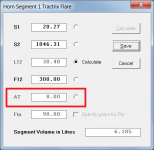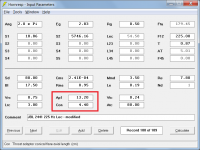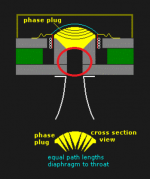Hi kokoriantz,
So if I understand it you make your own flare after the exponential part.
You mean with pink noise if it sounds to bright the opening flare to fast and when it sounds to dark to slow?
So for the -6dB point I measure the speaker at Fc and rotate till I get the -6dB point?
Sorry but sometimes it's difficult to read technical English.
Rob
So if I understand it you make your own flare after the exponential part.
You mean with pink noise if it sounds to bright the opening flare to fast and when it sounds to dark to slow?
So for the -6dB point I measure the speaker at Fc and rotate till I get the -6dB point?
Sorry but sometimes it's difficult to read technical English.
Rob
Sorry for my English, I must translate from French . No , At first you don't need to innovate your own flare . The cardboard ruler cut at the shape of a known flare Tractrix for example will shape the petals . Then you decide the next flare to try according the sound you hear . Only at the end you would need to tailor a flare that lies in between two known ones. To know that when you use the driver at lower frequency than it is advised to use , the diaphragm starts moving in piston instead of generating waves on it's surface to be harvested by the phase plug . At this regime the sound gets impregnated by the resonance and it's Qts . This why the horn resonance and that of the driver must match for best damping.
I will try to find the Don Keele's equation that links half angle, frequency and diameter.
I will try to find the Don Keele's equation that links half angle, frequency and diameter.
Last edited:
Is it a big problem if it's not exactly 5 degrees?
Hi Rob,
Ideally the angles should be the same, but provided that the difference is not too great I think that you should be okay. If the cutoff frequency of the tractrix horn is increased to 300 Hz and the throat diameter is 2 inches (S1 = 20.27 cm^2) then the half-angle at the throat entry becomes 8 degrees.
Kind regards,
David
Attachments
And is there an example from a JBL 24** driver I can use in Hornresp.
JBL 2441 225 Hz Lec:
GM
Attachments
JBL 2441 225 Hz Lec:
Hi GM,
Doesn't the JBL Model 2441 compression driver have an exit diameter of 2 inches?
If so, then shouldn't the S1 value be 20.27 cm2 rather than 11.64 cm2, to match the driver?
Am I missing something here, perhaps?
Kind regards,
David
Hi David,
I think that's the opening at the phase plug, after that there's a conical part from 41mm to 49mm and 44mm long.
Rob
I think that's the opening at the phase plug, after that there's a conical part from 41mm to 49mm and 44mm long.
Rob
I think that's the opening at the phase plug, after that there's a conical part from 41mm to 49mm and 44mm long.
Hi Rob,
In that case, then perhaps it would be better to include a 44 mm long conical throat adaptor before the horn proper, as shown in the attachment.
Kind regards,
David
EDIT - The "two segment" configuration suggested above does not allow directivity response to be calculated, which may be an issue.
Attachments
Last edited:
Am I missing something here, perhaps?
Greets!
What Rob said, most of the vintage drivers have the W.E. conical horn inside to cover the HF above the horn's gain BW. AKA 'rubber throat' that predates PWK what? 15-20 yrs?
GM
Thank's GM
You're welcome! Now if I could just remember who gave it to me. 🙁 IIRC he said the specs he used to derive the T/S specs was published in one of John Eargle's books.
GM
What Rob said, most of the vintage drivers have the W.E. conical horn inside to cover the HF above the horn's gain BW. AKA 'rubber throat' that predates PWK what? 15-20 yrs?
Thanks GM.
It is interesting that if the duct inside the compression driver is intended to act as a 'rubber throat' then it would need to have a flare rate greater than that of the horn to which it is connected, which means that the driver exit angle would be greater than that of the horn throat, so that for this case at least, it would not be possible to match the two angles exactly.
Without thinking about it too deeply previously, I had just assumed that the driver exit angle would always be less than, or at best equal to, the horn throat angle. Certainly not greater than 🙂.
Kind regards,
David
Attachments
- Status
- Not open for further replies.
- Home
- Loudspeakers
- Multi-Way
- Design Tractrix or Le Cleach for JBL 2446


